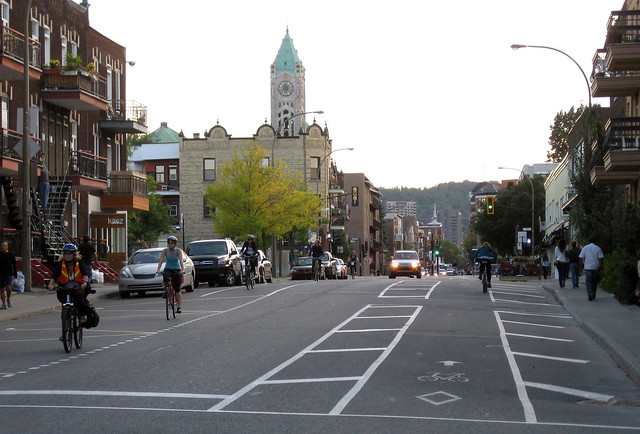
Bicycles tend to be quiet, flexible, and take up little space. Unfortunately, this affords cyclists relatively little visibility on the city streets. Jean-Francois Rheault, North American director of Eco-Counter, a company that specializes in counting pedestrians and cyclists, says that, consequently, engineers tend to underestimate the number of cyclists on Montreal’s bike network by a factor of 10 – 100.
Fortunately, Eco-Counter is tallying the true number of bicycle trips on ten of Montreal’s most important bike paths. At conferences he attends, Rheault says, local engineers will guess that a bike path like de Maisonneuve is used by 80-800 cyclists per day when in fact Eco-Counter’s sensors have recorded up to 8000 trips on a sunny weekday (on a rainy day there will still be around 4000 trips).
Last year, McGill University analyzed data from five of Eco-Counter’s sensors and concluded that bicycle trips in Montreal had increased 35-40% between 2008 and 2010 (Gazette article). Rheault shared some of this year’s findings with Spacing Montreal.
Cycle trips up 125% on Laurier Avenue in 2011
When the Plateau Mont-Royal borough introduced two bike lanes on Laurier Avenue and reduced motorized traffic to a single lane, the number of cyclists to use this route more than doubled. In May 2011, eco-counter recorded an average of 980 cyclists per day on Laurier Ave. After correcting for differences in the season, they calculated an average of 2200 trips per day after the bike lanes were introduced, a 125% increase! (The seasonal correction factor is calculated from hourly, daily, and monthly fluctuations in usage, as well as fluctuations due to weather conditions, from all 10 bicycle counters in Montreal).
While this increase probably does not represent new cyclists on the streets, it is interesting to note that the number of bikes on Laurier Ave is now approaching the number of cars on Laurier before the modifications were made (between 2000-4000 car trips per day). In this light, it does not seem so extreme to give half the street over to cyclists!

Rheault also says preliminary studies have shown a 10% increase in bicycle trips on the Boyer bike path in Petite Patrie between 2010 and 2011. He attributes this increase to the construction of a separated bike path on Christophe Colomb that provides a safer and more comfortable way to cross the CP tracks.

And while de Maisonneuve remains the busiest bike path in the city, Rheault says that they have recorded as many as 300 bike trips within 15 minutes on Milton street near University. Ideally, he says this kind of information should affect how the cycling network is designed in particular locations.
Helping cyclists gain visibility on city streets

Even after learning where eco-counter’s sensors were located* and what to look for, I barely noticed the thin, diamond-shaped marks in the bike path (you can spot one in the photo at the top of the post). But each time that a pair of bike wheels cross the loop, they interrupt an electromagnetic field and the signal is transmitted to a nearby sensor and recording device. Though the technology is developed by Eco-counter, they are owned, installed and maintained by the City of Montreal. Once a month, a City worker downloads the information and sends it to researchers at Eco-counter and McGill university who crunch the numbers.
Ottawa also recently installed five bicycle counters, and will be putting in another three very soon. But they have created an even more dynamic system, where sensors are hooked up to a modem that transmits the bike-tally on a daily basis. According to Rheault, transmitting data by modem is cost effective compared to manually downloading it. More importantly, the data becomes easily accessible to the public, so anyone can check how many people have cycled Ottawa’s Laurier path on a given day.
This fall, Ottawa is taking it up another notch by installing a bicycle barometer which will publicly display the real-time bicycle count in a public place. Should be a great antidote to drivers who complain that bike paths are underused: just because cyclists aren’t in gridlock, it doesn’t mean we aren’t using the streets!
*The ten eco-counter sensors are currently located on Berri, de Maisonneuve (2 locations), Saint-Urbain, Bréboeuf, Rachel, Parc south of Duluth, Pierre Dupuys (measuring bikes heading to the Jacques Quartier bridge), Côte-Sainte-Catherine, Christophe-Colomb and Univeristy.

5 comments
I wonder whether these are new trips or whether the bike path on Laurier is sufficiently attractive to divert trips which would have taken St-Joseph, St-Grégoire, etc.
I have worked on St-Joseph for years, and I have never encountered many cyclists. It’s probably one of the most unpleasant traffic sewers in the Plateau; no wonder they stay away.
i live on parc and bernard, and anytime i’m heading east >5 blocks i make a point to use laurier, because it is incredibly pleasant compared to everything else (rachel bike path included – that thing is narrow and scary). it’s much safer and more efficient on laurier, the flow of bikes occupies more or less a slow and fast lane, and people aren’t opening car doors in my face all the time. i love it, and i’m not surprised it’s getting so much use. thanks for the great article spacing montréal!
One of the best things about the Laurier bikeway is that eastbound between St Laurent and St Hubert (if memory serves) there is no adjacent car parking, which means you won’t get doored. Alas, east of St Hubert, you can still get doored, which really sucks, as you can see here:
http://www.youtube.com/watch?v=CudJvSbS2aY
West bound, the new bike path on Laurier between Brébeuf and Saint-Laurent was needed. It is much safer than Saint-Joseph-highway, Mont-Royal-door-prizes, Marie-Anne-war-zone, or Rachel’s-dangerous-bike-path.
Drivers can keep complaining, that was a great move.